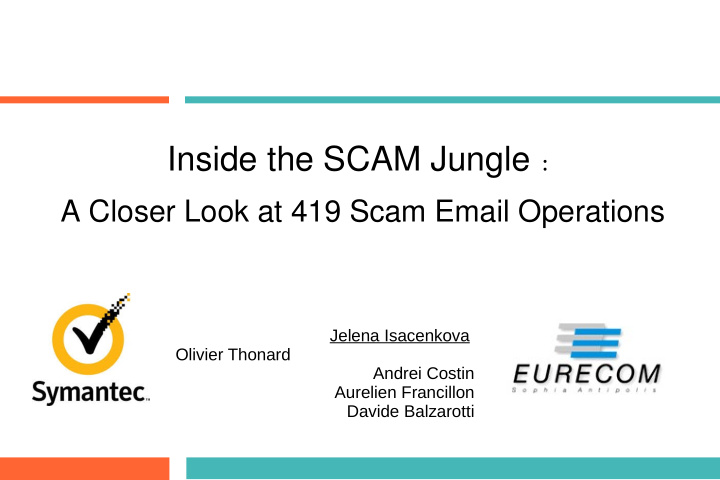



Inside the SCAM Jungle: A Closer Look at 419 Scam Email Operations Jelena Isacenkova Olivier Thonard Andrei Costin Aurelien Francillon Davide Balzarotti
Nigerian Scam Trap 2
Nigerian Scam Trap 3
Spam vs. 419 Scam 419 SCAM SPAM Low-volume High-volume ― ― Hide behind webmail accounts Highly dynamic infrastructure ― ― Manual sending Automated sending ― ― Trap with social engineering Trap victims through engineering ― ― techniques effort Contact with victims via emails Contact with victims over URLs ― ― and/or phone numbers 4
Why we study campaigns ― The goal: – identify and characterize 419 scam campaigns – find predictive scam email features ― Our assumptions: – Scam is likely sent in campaigns, like Spam – Emails and phone numbers are personal scammer assets (Costin et al., PST'13) => linking features 5
Outline ― Dataset ― Methodology ― Experimental results ― Conclusions 6
Dataset 7
Dataset ― Public data from 419scam.org ― From January 2009 till August 2012 ― 36,761 scam messages ― 12 countries (Europe, Africa and Asia) ― 34,723 unique email addresses ― 11,738 unique phone numbers 8
Scam origins by phone numbers 9
Scam origins by phone numbers Nigeria – 30% Benin – 14% South Africa – 5% 10
Scam origins by phone numbers UK Nigeria – 30% Personal Numbering Services (PNS) Benin – 14% South Africa – 5% 11
Scam origins by phone numbers UK Nigeria – 30% Personal Numbering Services (PNS) Benin – 14% Spain – 4% Netherlands – 3% South Africa – 5% 12
Data categories 13
Methodology 14
TRIAGE ― Security data mining framework (Thonnard et al. at RAID'10, CEAS'11, RAID'12) ― Multi-dimentional clustering ― Links common elements together forming clusters/campaigns 15
TRIAGE, part 2 16
Experimental results 17
Campaigns 1,040 campaigns identified, with at least 5 messages each ― Top 250 campaigns on average: ― – Long and scarce: last for one year and have only 28 active days – Small (38 emails): keep low-volume , could be unorganized – Use 2 phone numbers – Use 6 Reply-To email addresses – Use 14 From email addresses 18
Re-use of emails and phones 19
Re-use of emails and phones Being re-used on average 2,5 months Being re-used on average 6 months 20
Examples 21
22
Main traits: Single phone number Two campaign topics Long lived 83 emails 23
Fake lottery 1 year 24
“Eskom generates approximately 95% of the electricity used in South Africa and approximately 45% of the electricity used in Africa.”, - Escom
Different topics over time Main traits: Topics change Monthly package of emails Single phone number 58 emails
Different topics over time Main traits: Topics change December January Monthly package of emails Single phone number 58 emails November February March
iPhone campaign Main traits: One topic Two phone numbers Big re-used email package 190 emails
Macro-clusters ― Link strongly connected clusters into loosely connected ― Linked through emails and/or phone numbers ― 62 macro-clusters, 195 inter-connected clusters 29
Top macro-clusters ― Some are organized groups operating on international scale ― Fake lottery scam is primarily run by scammers located in Europe that are connected with African scammer groups 30
Clusters by countries ― Majority of unclustered data present isolated African actors => unorganized ― Macro-clusters cover African and many European actors => bigger organized groups covering Western markets 31
Clusters by countries Unclustered: ― Majority of unclustered data stealthy or isolated scammers present isolated African actors => unorganized ― Macro-clusters cover African and many European actors => bigger organized groups covering Western markets 32
Clusters by countries Unclustered: ― Majority of unclustered data stealthy or isolated scammers present isolated African actors => unorganized ― Macro-clusters cover African and many European actors => bigger organized groups covering Western markets Organized 33
Conclusions Emails and phone numbers play a crucial role in Nigerian email scam – Campaigns are long and scarce – Scammers hide behind webmail and forwarded phones – Scam campaigns differ in their infrastructure, orchestration and modus operandi – Different scammers probably compete for trendy topics, thus changing topics over time 35
36
Recommend
More recommend